As an art historian, the case of Frida Kahlo troubles me. With her image cartooned and printed onto mugs, tote bags, makeup sets, candles, notebooks, and toys I am troubled by what she has become. And yet, I am proud that she has become a global reference point and, in many ways, the emblem of Mexican identity.
To me, she is not a T-shirt, a figurine stamped “Made in China,” or a kitschy mash-up of her portrait and Day of the Dead imagery. She is a complex, sophisticated artist who has been exoticized, over interpreted, poorly explained and too often stripped of the world in which she lived.
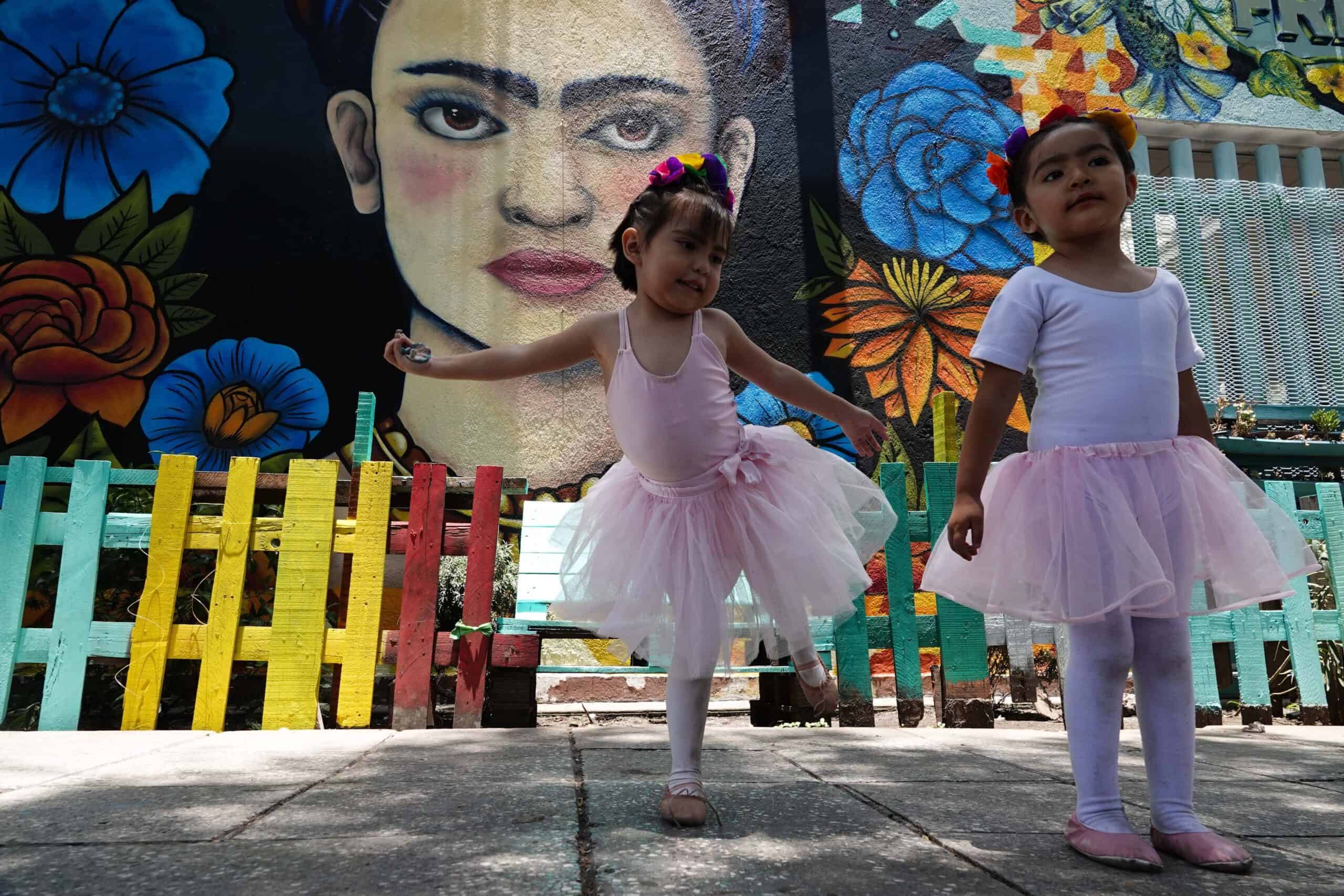
Before she was “Frida”
Magdalena Carmen Frida Kahlo y Calderón was born in 1907 in the Casa Azul, her family’s cobalt-blue house in Coyoacán, on the southern edge of Mexico City. She later claimed 1910 as her birth year, aligning herself with the outbreak of the Mexican Revolution, as if rebellion itself could be inscribed into her very biography.
Her father, Guillermo Kahlo, was a German immigrant who became a naturalized Mexican citizen and carved out a career as the first official photographer of the nation’s cultural patrimony under Porfirio Díaz. His work documenting churches, monuments, and civic architecture provided the Kahlo family with the financial stability to build Casa Azul and give his daughters the finest education.
Guillermo was cultured, liberal and enamored of the arts. His studio, with its oils and brushes, became Frida’s refuge. There she first learned to paint. She also absorbed the visual discipline of photography: framing, posing, retouching. This early training explains the uncanny precision of her canvases. She grasped an essential lesson: that painting could hold what photography could not.
Her mother, Matilde Calderón, offered a stark contrast — devoutly religious, deeply conservative, and insistent that women existed to serve men. In the Kahlo household, the rosary was a daily fixture and the family kept a designated pew at church. Frida resisted.
Illness struck early. At six, she contracted what her parents believed to be polio, which left her right leg thinner than the other. Some biographers suggest it was more likely spina bifida, a congenital condition also seen in her sisters. The schoolyard was merciless: classmates mocked her as “Frida Kahlo, pata de palo (peg leg).” She confessed to wearing layers of socks to hide her insecurity.
At fifteen, she declared to her parents that she intended to study medicine — perhaps a way of grasping her own fragility. She entered the Escuela Nacional Preparatoria (ENP), the only one in Mexico at the time. Out of 2,500 students in her generation, just 35 were women. Frida was one of them.
At the school she met her first great love, Alejandro Gómez Arias, with whom she carried on a four-year romance. But she also glimpsed Diego Rivera, already a cultural rock star, painting a mural in the auditorium. Watching him from the hallways, she reportedly told classmates, “I’m going to marry that man.” They laughed.
Her years at ENP were turbulent. An affair with a female teacher and political activism led to her expulsion. She apprenticed instead with an engraver, who recognized her talent. She was beginning, quietly, to make her way as a painter.
Then came the crash
On September 17, 1925, a bus carrying Frida collided with a streetcar. The bus split apart. Frida was impaled by a metal handrail and left with a fractured pelvis, broken spine and shattered ribs. These injuries would leave her in chronic pain for the rest of her life. She was just seventeen.
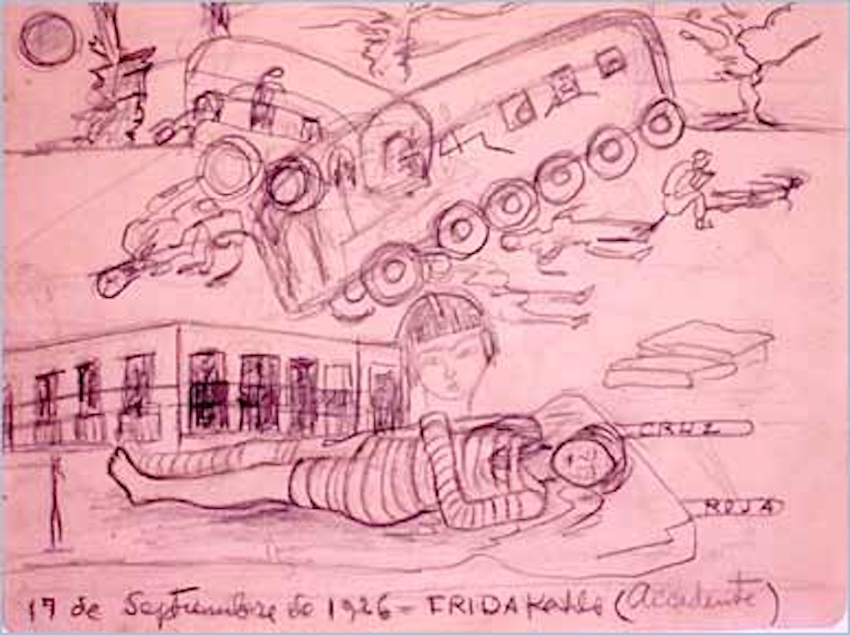
She spent a month in the hospital and several more bedridden at home. Her mother rigged a mirror above her bed and had a special easel built. Her father gave her his prized collection of brushes and paints. In unbearable pain she began her first canvases. Her early works bore the mark of her training in photography and her exposure to Renaissance art.
In 1926 she painted her first known self-portrait as a gift for her boyfriend Alejandro. “The portrait will be in your house in a few days,” she wrote him. “I beg you to place it somewhere low, where you can contemplate it as if you were looking at me.”
Soon after the relationship with Alejandro ended, as did her medical ambitions. Instead, she found in art, in the Communist Party, and in Diego — who embodied both art and communism — her leitmotif.
Mexico’s power couple
By the late 1920s, Diego Rivera was already a towering figure — not only physically, but also artistically. By the time Frida sought him out, he was already considered the national painter.
Armed with a handful of canvases, Frida approached Rivera at one of his mural sites, and demanded he come down and judge them. “I have not come to flirt with you,” she told him bluntly, “I have come to show you my painting.” Rivera was impressed.
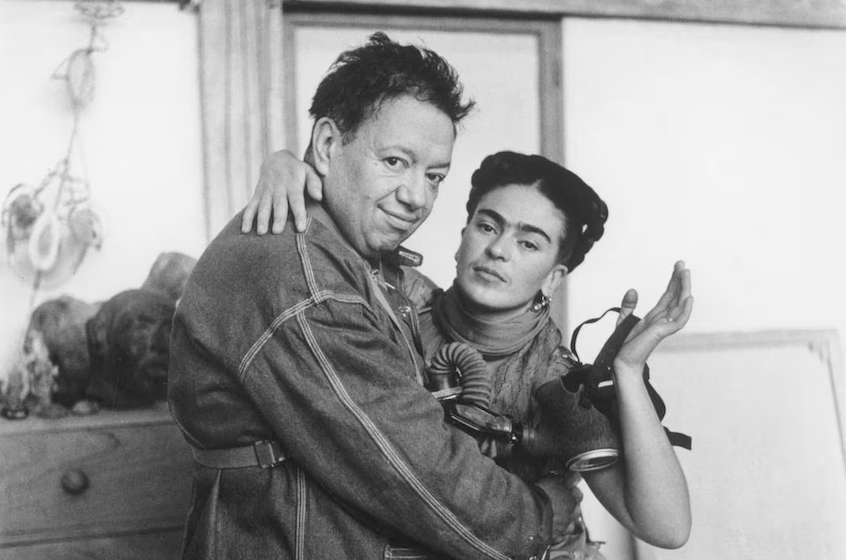
What followed was one of the most tempestuous relationships in modern art. Diego was 21 years older, twice her size, already married twice, and a notorious womanizer. He embodied everything her conservative mother despised and everything she herself longed to challenge.
In 1929, they married. Her parents, scandalized by the match, called it the “marriage of an elephant and a dove.” But Frida was no dove. She demanded equality, and she wielded wit and defiance like weapons.
The marriage was punctuated by infidelities, reconciliations, and creative symbiosis. Frida once confessed “I suffered two accidents in my life. The first occurred when a streetcar ran me over. The other accident is Diego.”
Despite — or perhaps because of — their turbulence, the couple thrived artistically. Their home became a meeting point for artists, exiles, and revolutionaries. Leon Trotsky himself would live for a time in their orbit. And while Diego painted sweeping public epics, Frida turned inward, onto the canvas of her own body and soul.
Painting pain
What makes Kahlo’s art remarkable is not just its technical finesse but its brutal honesty. She transformed her own body into a landscape of suffering, desire, and endurance. Her canvases are intimate confessions, coded diaries in oil.
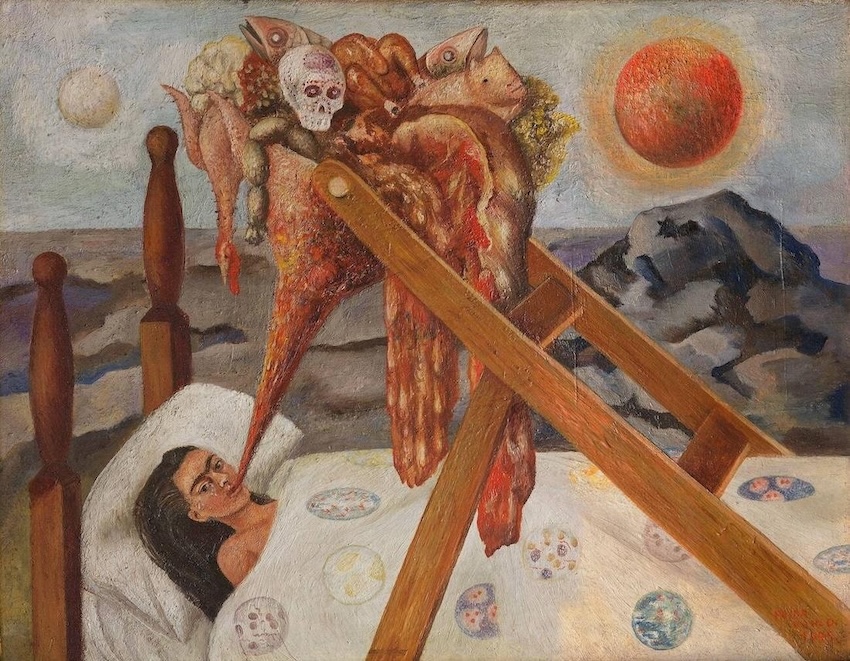
Unlike Rivera, who covered walls with sprawling murals of peasants, workers, and revolution, Frida painted herself over and over again. Out of 143 known works, 55 are self-portraits. Yet they were not exercises in vanity. They were acts of survival.
“My painting carries within it the message of pain,” she once wrote. In The Broken Column (1944), her torso is split open, her spine replaced with an Ionic column that is cracking. Her body is strapped in a steel corset, her skin punctured with nails. In Without Hope (1945), she lies in bed, gagging as a funnel force-feeds her meat, fish, and entrails — a direct reference to her medically prescribed diets.
But her art was never only about pain. It was also about defiance. In works like Self-Portrait on the Borderline Between Mexico and the United States (1932), she sets herself between two worlds: the industrial smokestacks of Detroit and the fertile soil of pre-Columbian Mexico. She holds a Mexican flag, small but unyielding, staking her claim to cultural belonging.
Her canvases borrow from retablos, the small devotional paintings common in Mexican Catholic households. They borrow too from Surrealism, though she rejected the label. “They thought I was a Surrealist,” she stated, “but I wasn’t. I never painted dreams. I painted my own reality.”
To paint was to give form to what was otherwise unbearable: miscarriages, surgeries, Diego’s infidelities, her bisexual affairs, and her fragile health. She made art out of the raw material of her existence.
Politics
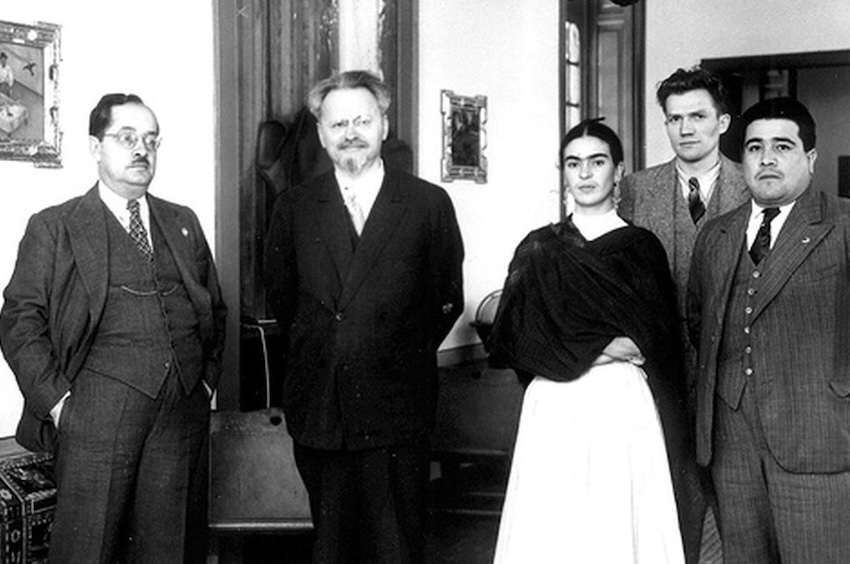
Frida and Diego were not only artists; they were also political actors in a Mexico still shaping its revolutionary identity. Both joined the Communist Party, convinced that art and politics were inseparable. For Rivera, murals were propaganda on a grand scale. For Kahlo, painting was private but no less political: the assertion of her Mexican identity, her body, and her voice.
In 1930, the couple left Mexico for the United States, where Diego had received commissions in San Francisco, Detroit, and New York. Frida called the U.S. “gringolandia” and often mocked its obsession with money and machinery. Yet her time there expanded her artistic vocabulary. In Detroit she painted Henry Ford Hospital (1932).
Her work here was one of her most evocative, depicting the ex votos that were part of Kahlo’s Catholic upbringing. These images, where the faithful would draw icons of their pain and suffering while giving thanks to their chosen saints, were a way of exorcising her own traumatic demons. She painted a snail, a dead fetus (a son she had miscarried earlier that year), her wounded body, her battered pelvis, a withered flower and medical equipment. The city of Detroit sits in the background with all its industry. In the center, the bed like an island where Frida lies alone, crying with all her fears, holding a red cord that connects everything.
Returning to the Casa Azul in 1934, Frida’s circle of friends widened to include poets, painters, and political exiles. Among them was Trotsky with whom Frida embarked on a brief affair — more a gesture of rebellion than of passion. She later offered him Self-Portrait Dedicated to Leon Trotsky, where she stands stiffly, holding a bouquet and a note of dedication.
Politics swirled around her, but it never drowned her. For Kahlo, ideology was in the assertion of identity, the rejection of bourgeois convention, and the embrace of Mexico’s indigenous heritage.
Frida’s recognition
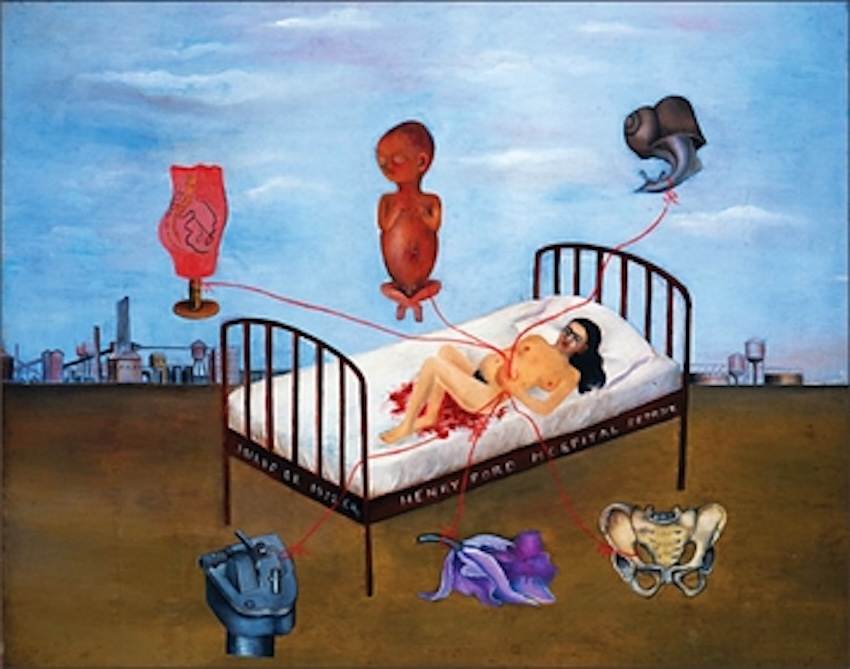
Her marriage was turbulent, but separation never lasted. Frida began affairs with men and women alike in response to Diego’s romances. While she kept her affairs with men discreet, those with women were even boasted about by Diego himself.
Strangely, this way of living made Frida prolific during the late 1930s. Frida painted herself with her monkey, her childhood nurse, and her own thoughts reflected in bathwater. Her canvases grew more ironic, playful, even humorous.
In 1938, André Breton arrived in Mexico. He was captivated not by Rivera but by Kahlo. “I didn’t know I was a Surrealist until Breton told me,” she quipped. At his urging, she exhibited in Paris the following year. After many disagreements with Breton over poor organization, Frida wrote to one of her friends: “You have not the least idea what kind of cockroach Breton is, along with almost all the surrealist group. In a few words, they are all sons of… their mother […] And all this resulted in fights, insults, discussions, gossip, much anger and problems of the worst kind. Finally, Marcel Duchamp (the only one of the artists and painters here who has his feet on the ground and his brains in place) managed to organize the exhibition with Breton. It opened on the 10th of this month at the Pierre Colle gallery, which, I’m told, is one of the best in the place. There were many people on opening night, many congratulations to the ‘little girl,’ including a strong embrace from Joan Miró and great praise from Kandinsky for my painting; congratulations from Picasso, Tanguy, Paalen and other ‘great shits’ of surrealism.”
Disappointed with the French art scene, she returned to la Casa Azul, only to find Rivera demanding a divorce. Devastated, Frida painted The Two Fridas — the European one Diego never loved and the Mexican one who was for Diego. She had explored dualities before in other paintings like life and death, but none as painful and direct as she did here.
Betrayal
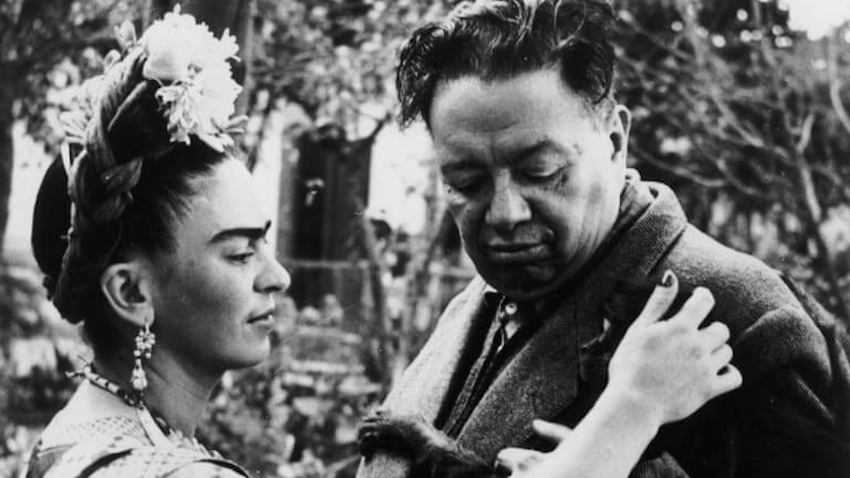
In 1940, she and Rivera remarried under unusual conditions: they would not share a home, not sleep together, and she would be financially independent. Whether those terms were real or rhetorical hardly mattered. What mattered was that Frida’s career was blossoming.
The 1940s brought exhibitions abroad and teaching at La Esmeralda, where she mentored the group later known as Los Fridos. Her diary from this period — illustrated with drawings, confessions, poems — became her most intimate work.
But her health deteriorated. Surgeries offered brief reprieves; alcohol and Demerol dulled the pain. Her canvases grew rawer, strokes more violent, precision replaced by anguish.
In 1953, her friend the photographer Lola Álvarez Bravo organized the first solo exhibition of her work in Mexico. Doctors advised against her attending. Frida arrived by ambulance, carried to her bed in the gallery, dressed in traditional costume, made-up and perfumed. Two hundred guests — artists, writers, politicians, friends — celebrated her life. The party lasted until dawn.
Months later, after the amputation of her leg, she wrote in her diary: “Feet, what do I need you for, when I have wings to fly?” A year later she wrote “I hope for a joyful exit — and I hope never to return.”
She died in July 1954, at 47. Rivera broke down as her body was cremated, flames illuminating her like one of her own canvases.
Legacy
By the time of her death, Frida Kahlo had created 271 works. Through them she gave form to what women of her generation were not supposed to voice: the realities of illness, miscarriage, desire, infidelity, sexuality and political opinion.
Who has not feared death, loved unevenly, struggled with parental expectations or tried to show the world a braver face than they felt inside? Kahlo’s genius was to make private wounds into collective mirrors.
Her symbolic vocabulary — monkeys, fruit, flowers, Catholic saints, pre-Columbian idols — is at once autobiographical and mythic. Her style may repel classical tastes, but her force is undeniable.
So, how does a woman who painted her political views, pains, likings, fears, insecurities, and adorations become a marketing product? Find out next week, as we take a look at the Fridamania phenomenon.
María Meléndez is a Mexico City food blogger and influencer.




